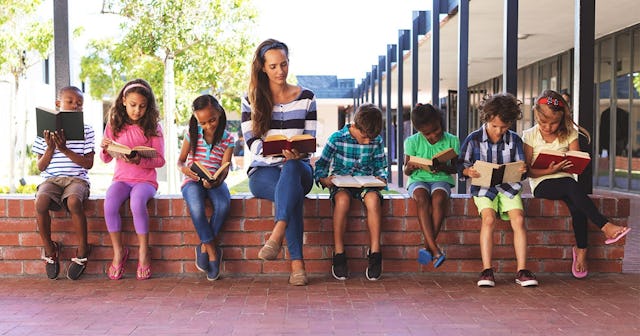Schools Should Be Doing Outdoor Classes As Often As Possible

Today I got a text from my children’s school informing me that they had released their plan for schools to be open five days a week come fall. Their strategy to keep children and teachers safe contained pretty much what I expected: masks on teachers and students, smaller classes to provide students with ample space for social distancing, and fever checks each day. But what wasn’t discussed in the plan, and what I have not seen discussed anywhere else except for a recent New York Times article by Ginia Bellafante, was the idea of holding class outside.
According to Bellafante’s NYT article, back in 1907, tuberculosis ravaged American cities, and the solution was to create open air schools. The first one was on Rhode Island. Naturally, online classes were not an option, and no one discussed putting glass dividers between desks. Instead, they held classes in parks, and other open spaces, sometimes under tents. Desks were moved outside, along with chalk boards and podiums. Children kept warm with blankets and coats, along with heated soap stones at their feet. None of the children contracted tuberculosis at that first open air school, and within two years there were 65 open-air schools around the country. Some inner city schools were even held on rooftops.
I know some of you are thinking that putting children out in the cold to keep them well doesn’t line up, but it worked in 1907, and it could work today. The rate of transmission of any illness, including COVID-19, goes way down when people are outside; a review of 7,000 cases in China recorded only one instance of fresh-air transmission.
diego_cervo/Getty
Furthermore, teaching children outdoors has advantages in and of itself. Before COVID-19, many schools were working toward creating gardening programs on their campuses. According to Dallas News, the REAL School Gardens nonprofit out of Fort Worth has planted over 100 gardens and trained teachers how to use them. Their program has found that having a school garden results in a 15% increase in standardized test scores, and 94% of teachers report that they noticed an increase in student engagement. A 2018 study conducted over an academic year looked at the emotional, cognitive and behavioral challenges facing 161 fifth graders. It found that those participating in an outdoor science class showed increased attention over those in a control group who continued to learn conventionally.
Obviously, putting children in outdoor school does not solve all of our nation’s educational issues. I can speak for my children’s school. We live in rural Oregon, and there is plenty of open space to put up tents and hold class outside next to the schools main building. But in urban areas, finding enough space to hold school outdoors could be a challenge. There is also the issue of holding classes where children could wander into traffic, or be distracted by noisy intersections. And yes, some children might suffer from allergies or even sensory issues, and would struggle to learn outdoors.
Klaus Vedfelt/Getty
There is also the issue of transportation. Placing children on a bus can create a literal petri dish for COVID. I know with my children’s school, bussing was completely shut down, and parents have had to work with their employers to flex their schedules so they can drop children off at school personally. This option has created a hardship for many families, and for some low income families it has caused them to only be able to do school remotely.
However, the concern here is that outdoor classes are not being discussed widely, and it seems clear that this is shortsighted on the part of the American education system. Rather than discuss having children at school part of the week, and at home learning remotely part of the week, why not have them have class outside part of the week? Why not have students building a garden and learning about how food grows? Why not take them bird watching in the fall and spring at a local park, or teach them to name local trees? Or perhaps have them engage in nature writing and poetry? Why not explore the option of outdoor class with local city councils and see what is available in the area, and find funding to hold class in tents or under picnic shelters at local parks?
The rate of transmission would go down, while also teaching our children about the world around them. Parents are scrambling to figure out safe child care, trying to figure out how to work from home while educating their children, an experiment that was thrust upon most of us last spring. I don’t want to speak for everyone, but in my house, it didn’t go well.
The Trump administration is pushing for schools to be open, and yet the topic of holding classes outside is completely off the table. But if they have to be open, then why not open-air? Frankly, it’s a viable option that we should be exploring further.
This article was originally published on